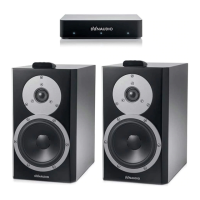12 Dynaudio
The Xeo system
Xeo consists of several high-quality components that are optimally matched. When combined, they
can fulll the most demanding requirements for a wireless multi-room and multi-source system.
NOTE:
This manual describes all of the available Xeo components. It is possible that only a few of the
descriptions are relevant to you, depending on your system conguration.
Components
Xeo Hub The Xeo Hub is the control center for the Xeo system. Signal sources such as
tuners, receivers, CD players, TVs, streaming clients, network players, MP3
players, or computers are connected to it. Signals are sent via radio from the
Hub to the loudspeakers (or Xeo Link) where they are then played back.
Xeo Extender The Xeo Extender extends the reception range of the Xeo Hub. As a result,
Xeo loudspeakers or other Xeo components can be operated further away
from the Hub.
Xeo Link The Xeo Link receives wireless signals from a Xeo Hub and outputs analog
and digital signals from its connections. As a result, you can also connect
active subwoofers, active loudspeakers, or other components to the Xeo
system. Xeo Link can also be connected with a 1st generation Xeo Hub
(transmitter).
Xeo remote
control
The Xeo remote control can be used to turn the loudspeakers on and off,
change the volume, and select a Hub and its connected signal sources.
Xeo
loudspeakers
The active Xeo 4 and Xeo 6 loudspeakers receive the wireless signals from
the Hub and play them back in optimal sound quality. They have an integrated
amplier and can be controlled with the Xeo remote control. A display
indicates the operational state of the system and lets you switch it on/off or
change the volume without using the remote control.

